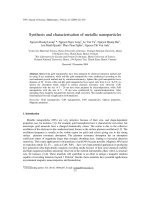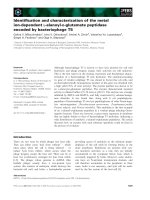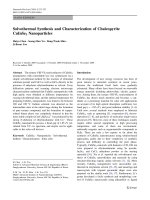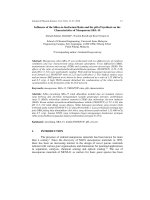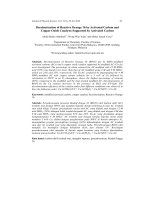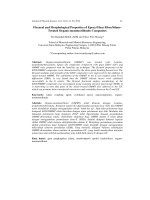Báo cáo vật lý: "Mechanochemical Synthesis and Characterisation of Bismuth-Niobium Oxide Ion Conductors" ppsx
Bạn đang xem bản rút gọn của tài liệu. Xem và tải ngay bản đầy đủ của tài liệu tại đây (368.74 KB, 12 trang )
Journal of Physical Science, Vol. 20(1), 75–86, 2009 75
Mechanochemical Synthesis and Characterisation
of Bismuth-Niobium Oxide Ion Conductors
S.N. Ng
*
, Y.P. Tan
*
and Y.H. Taufiq-Yap
Department of Chemistry, Faculty of Science, Universiti Putra Malaysia,
43400 UPM Serdang, Selangor, Malaysia
* Corresponding authors: ,
Abstract: Bismuth niobate solid solutions, Bi
x
NbO
δ
(2.5 ≤ x ≤ 6), have been prepared
using a mechanochemical method. The solid solutions were also prepared using a solid-
state conventional method for comparison purposes. Bi
3
NbO
7
was successfully obtained
via a mechanochemical method at a lower synthesis temperature (milled at 1000 rpm for
one hour followed by heating at 700
o
C for 24 h) than the conventional solid-state method.
Electrical properties of the single-phase materials were studied by AC impedance
spectroscopy. Further characterization of the materials was carried out using differential
thermal analysis (DTA) and thermogravimetric analysis (TGA). The results showed that
no thermal changes and phase transitions were observed and all materials were
thermally stable.
Keywords: bismuth niobate, mechanochemical, solid-state reaction, impedance
spectroscopy
1. INTRODUCTION
Ionic conductors have provided a fascinating interdisciplinary field of
study for over a century. In oxygen ion conductors, current flow occurs by the
movement of an oxide ion through the crystal lattice. As well as the intrinsic
interest in these materials, there has been a continued drive for their applications
in technological devices such as solid oxide fuel cells (SOFCs), oxygen sensors,
and many other applications. These entire devices offer the potential of enormous
commercial and ecological benefits provided suitable high performance materials
can be developed.
1–4
Yittria-stabilized zirconia (YSZ), which is used as the
electrolyte in SOFC operates at a temperature around 1000
o
C. Thus, high
operating temperatures will result in high fabrication costs and also affect the
material stability and compatibility and the thermal degradation of the electrolyte
itself. Therefore, there is a continuing effort to search for oxide ion conductors
that can operate at lower temperature in order to reduce costs.
Mechanochemical Synthesis and Characterisation 76
Bismuth oxide, Bi
2
O
3
, is recognized as a good oxide ion conductor due to
its crystal structure (fluorite type) and its high ratio of oxygen vacancies. Bi
2
O
3
exists in four polymorphs, which are α, β, γ, and δ. The high-temperature form of
bismuth oxide, δ-Bi
2
O
3,
which has an oxygen-deficient fluorite-type structure, has
been recognized as one of the best solid-state oxide ion conductors due to the
high concentration of intrinsic oxygen vacancies.
5
However, δ-Bi
2
O
3
is only
stable in a narrow temperature range from 730
o
C to its melting point at 824
o
C.
Below 730
o
C, the monoclinic α-Bi
2
O
3
is the stable phase. In order to enhance the
stability of the high-temperature and highly conducting δ-phase, it can be doped
with transition metal oxides such as Nb
2
O
5
, Ta
2
O
5
, WO
3
or rare-earth oxides.
6–9
Among the many choices of substituting cations in δ-Bi
2
O
3
, Nb
5+
is probably the
most frequently used due to its high efficiency in stabilizing the cubic phase at
room temperature.
10
Bismuth niobate (Bi
3
NbO
7
) exists in two crystallographic configurations,
a tetragonal (type III) phase and a pseudocubic (type II) phase. The tetragonal
phase shows a higher electrical conductivity than the pseudocubic phase. It was
suggested that this is associated with the redistribution of the oxygen sublattice
(or oxygen vacancies) induced by superstructure ordering in tetragonal Bi
3
NbO
7
,
which appears to increase the mobility of free charge carriers and therefore
improves the electrical conductivity.
The plots of ionic conductivity versus
reciprocal temperature are adequately fitted by the Arrhenius law: σ
T
= σ
0
exp
(-E
a
/KT). The activation energies (E
a
) of oxygen ion diffusion for the Type II
phase was higher than the Type III phase. The lower diffusion activation energy
of the tetragonal phase shows that the Type III Bi
3
NbO
7
structure offers a lower
energy barrier to oxide ion migration than the Type II phase. Over the entire
temperature range, the tetragonal phase exhibits a higher electrical conductivity
than that of the cubic phase.
10–11
In this paper, we examine the properties of the
solid solutions in Bi
3
NbO
7
(type III), which include the phase purity, thermal
stability, and the electrical properties.
Preparation via a traditional solid-state reaction usually requires high
temperatures and long firing cycles leading to the inevitable coarsening of
particles and aggregation of the powders, which results in poor microstructures
and properties of electroceramics. The mechanochemical process, which is also
known as mechanical alloying, has been recently employed to prepare oxides and
compounds with smaller particle sizes. This technique is superior to both the
conventional solid-state method and wet chemistry-based processing routes for
several reasons. This method can provide better chemical mixing and produce
materials with smaller particle sizes, thus enhancing the electrical properties of
the materials. Furthermore, the mechanochemical method may produce single-
phase materials at lower temperatures and shorten the synthesis time.
12–13
Journal of Physical Science, Vol. 20(1), 75–86, 2009 77
2. EXPERIMENTAL
Solid solutions of Bi
x
Nb
1
O
δ
(2.5 ≤ x ≤ 7) were synthesized using a
mechanochemical and a conventional solid-state method. For the
mechanochemical method, the stoichiometric mixtures of Bi
2
O
3
(99.9% Aldrich)
and Nb
2
O
5
(99.9% Alfa Aesar) (total weight ~ 8 g) and 50 agate balls with
diameters of 10 mm were placed in an agate bowl (99.9% SiO
2
) with a maximum
volume of 250 ml. 120 ml of ethanol (99.8%, Fluka) was added as a milling
medium to prevent excessive abrasion. The mixture was milled using a planetary
ball mill (Model Pulverisette 4 vario-Planetary mill) at different speeds (700,
1000, and 1400 rpm) for one hour in order to determine the optimum milling
speed. The mixture was then dried at 80
o
C to evaporate the ethanol. For the
conventional solid-state method, however, 3.0–4.0 g of the mixture of the
required reagents were weighed and mixed manually using an agate mortar and
pestle. Heat treatments with different temperatures and durations were carried out
to ensure the formation of single-phase materials.
The samples were characterized via X-ray diffraction analysis (XRD)
(Shimadzu diffractometer XRD 6000, CuK
α
radiation) in the 2θ range from
10
o
–60
o
at 2
o
min
–1
. A chekcell refinement program was used to obtain the lattice
parameters of the structure. The thermal events of samples were studied from
room temperature to 800
o
C on heating and cooling cycles with a heating rate of
10
o
C min
–1
by DTA (Perkin-Elmer instrument with model DTA 7).
The electrical properties were determined by AC impedance
spectroscopy using a Hewlett Packard Impedance Analyzer, HP4192A, in the
frequency range of 5–13 MHz. Measurements were made from 200
o
C to 850
o
C in
incremental steps of 50
o
C on a heating cycle with a 30 min equilibration time.
3. RESULTS AND DISCUSSION
3.1 XRD Analysis
Figure 1 shows the phase evolution of Bi
3
NbO
7
synthesized by a
mechanochemical process with a milling speed of 1000 rpm for one hour. From
the results obtained, the mixture produced after milling one hour without any
heat treatment consists of raw materials that are Bi
2
O
3
and Nb
2
O
5
, indicating that
no reaction has occurred at this stage. After heating the precursor at 600
o
C for
24 h and 650
o
C for 72 h, traces of starting materials still remained, indicating that
the reaction was not complete. A single-phase Bi
3
NbO
7
was successfully
obtained after the ball-milled precursor was heated at 700
o
C for 24 h. The
Mechanochemical Synthesis and Characterisation 78
10 15 20 25 30 35 40 45 50 55 60
X
X
Y
Y
X
X
Y
Y
Y
X
X
X
Y
Y
X
X
XX
Y
Y
X
Y
X
X
Y
XX
X
Y
X
X
X
X
X
X
X
X
X
X
Y
X
YX
(e)
(d)
(c)
(b)
(a)
Intensity (arbitrary unit)
2 θ (
o
)
Figure 1: Phase evolution of Bi
3
NbO
7
synthesized via the mechanochemical
method (1000 rpm for one hour) with synthesis temperature (X = Bi
2
O
3
, Y =
Nb
2
O
5
): (a) without heat treatment; (b) 600
o
C for 24 h; (c) 650
o
C for 48 h;
(d) 700
o
C for 24 h; (e) 800
o
C for 24 h.
conventional solid-state method requires a higher temperature (800
o
C) and
24 h to obtain a pure phase compound. This may be due to the ball-milled
method, which can result in a better mixing of chemicals and therefore can speed
up the reaction rate and reduce the synthesis temperature.
The XRD patterns of Bi
x
NbO
δ
(2 ≤ x ≤ 7) solid solutions are shown in
Figure 2. Solid solutions with a single-phase were formed in the range of 2.5≤
x≤6. There is an expected small shift in the 2θ at ~28.20
o
due to the increasing Bi
content that can change the atomic arrangement in the structure, resulting in a
shift in the d-spacing.
11
Refinements were performed using a chekcell program
with a lattice of Bi
3
NbO
7
reported by Ling and Johnson as starting values.
11
All
of the peaks in the XRD patterns of these materials can be fully indexed in a
tetragonal system with a space group of I4m2.
Journal of Physical Science, Vol. 20(1), 75–86, 2009 79
10 15 20 25 30 35 40 45 50 55 60
#
*
*
*
*
(g) x=7
(f) x=6
(e) x= 5
(d) x= 4
(c) x= 3
(b) x=2.5
(a) x=2
Intensity (arbitary unit)
2 θ (
o
)
Figure 2: XRD patterns of Bi
x
NbO
δ
(2 ≤ x ≤ 7) prepared via the mechanochemical
method. (# = BiNbO
4
; * = Bi
5
Nb
3
O
15
)
Bi
2
NbO
5.5
(x=2), a mixed-phase that consists of Bi
3
NbO
7
and Bi
5
Nb
3
O
15
,
was obtained. The presence of the Bi
5
Nb
3
O
15
phase was indicated by unindexed
peaks at 2θ = 12.68
o
and 48.11
o
. For values of x larger than 6, a peak around
27.94
o
was obtained corresponding to BiNbO
4
, which is determined by
comparing the XRD pattern of Bi
7
NbO
13
to that of BiNbO
4
reported in ICDD
card number: 00-016-0486 indicating the presence of a mixed-phase. The
intensity of this peak did not change, even after heat treatment at 900
o
C for
72 h.
3.2 Thermal Analyses
DTA measurements were carried out on all of the solid solutions to
investigate the thermal events. Figure 3 shows the DTA thermograms of
materials in Bi
x
NbO
δ
(2.5 ≤ x ≤ 6) solid solutions at a heating and cooling rate of
10
o
C min
–1
. From the results, no thermal changes and phase transitions were
observed. Straight lines observed in the TGA thermograms for samples in the
solid solutions showed that there was no weight loss when samples were heated
to 800
o
C. This indicates that these materials were thermally stable.
3.3 Conductivity Measurement
The impedance (Z
*
) complex plane (Z
”
vs. Z
’
) plots measured at three
different temperatures (300
o
C, 550
o
C, and 800
o
C) for Bi
3
NbO
7
synthesized via
the mechanochemical method are presented in Figure 4. An equivalent circuit
consisting of two parallel RC elements connected in series as shown in
Mechanochemical Synthesis and Characterisation 80
Figure 3: DTA thermograms: (a) Bi
2.5
NbO
6.25
; (b) Bi
3
NbO
7
; (c) Bi
4
NbO
8.5
; (d) Bi
5
NbO
10
;
(e) Bi
6
NbO
11.5
synthesized by the mechanochemical method.
Figure 4(a) was used to interpret the Z
*
plots. One RC element, R
b
C
b
, models the
electrical response of the bulk, whereas the other, R
gb
C
gb
, models the grain
boundary response. The overall sample impedance is the summation of R
b
and
R
gb
. The complex plane plot of Bi
3
NbO
7
measured at 300
o
C is shown in Figure
4(a). Generally, the high frequency arc has an associated capacitance of around
10
–12
Fcm
–1
, which is a typical value for the bulk (intragranular) capacitance of a
sample. Figure 4(a) has a capacitance of this order and, thus, this contribution
was interpreted as resulting from the bulk resistance of the sample.
At 550
o
C a small, low frequency spike was observed as illustrated in
Figure 4(b), which is characteristic of an ionic polarization phenomenon at the
blocking electrode, which is known as a Warburg-response. At 800
o
C, the
diffusion of oxygen ions through the entire thickness of the electrode was seen in
the collapse of the spike into a semicircular arc [Fig. 4(c)], supporting the idea
that the conducting species were predominantly oxide ions. Similar impedance
data were observed for the solid solutions.
Combined spectroscopic plots of the imaginary components of the
impedance, Z
”
, and the electric modulus, M
”
, can be used as a general method for
probing the electrical homogeneity for ceramics. For an ideal Debye response
representing bulk properties, the frequency maxima of Z” and M” peaks should
be coincident and the half-height peak widths should be 1.14 decades on a log f
scale for a homogenous material.
14
The combined spectroscopic of M
”
and Z
”
versus the log f for Bi
3
NbO
7
(Fig. 5) showed two non-overlapping peaks at
0 200 400 600 800 1000
h
eat
cool
heat
cool
heat
cool
heat
cool
heat
→
→
→
→
→
←
←
←
←
←
cool
(e)
(d)
(c)
(b)
(a)
Temperature (
o
C)
Delta T (endo down)
100 200 300
400
400
300
200
100
0
Z' (kohm cm)
-Z'' (kohmcm)
(a) 300
o
C
C
p
= 9.88 x 10
-12
Fcm
-1
(a) 300°C)
0.5 1.0 1.5 2.0 2.5
2.5
2.0
1.5
1.0
0.5
0
Z' (kohm cm)
-Z'' (kohmcm)
(b) 550
o
C
C=1.21 x 10
-10
Fcm
-1
(b) 550°C
0 50 100 150 200
220
170
120
70
20
)
Z' (ohm cm)
-Z'' (ohm cm
(c) 800
o
C
C= 3.77 x 10
-9
Fcm
-1
Figure 4: Complex impedance plane plots for Bi
3
NbO
7
at (a) 300
o
C, (b) 550
o
C, and (c)
800
o
C.
Z' (kohm cm)
Z' (kohm cm)
Z' (kohm cm)
(
c
)
800°C
-Z ((kchm cm)
-Z ((kchm cm) -Z ((kchm cm)
Mechanochemical Synthesis and Characterisation 82
300
o
C. The half-height peak width of the M
”
peak has a value of around 1.57 on
the log f scale and this indicates that the conductivity measured is not that of the
bulk alone and the material may not be homogenous.
Conductivity measurements were carried out on single-phase materials.
Conductivity values were extracted from the AC impedance data. These materials
showed reproducible conductivity in the heating and cooling cycles. Figure 6
shows the Arrhenius plots of Bi
x
NbO
δ
(2.5 ≤ x ≤ 6) during the first cooling cycle.
The conductivity values range from 10
–7
to 10
–2
ohm
–1
cm
–1
between 250
o
C and
800
o
C. Among the materials prepared, Bi
6
NbO
11.5
has the highest conductivity
(5.0 x 10
–5
ohm
–1
cm
–1
at 300
o
C). Table 1 lists the conductivity values at 300
o
C
and 600
o
C, and the E
a
values for all of the samples of Bi
x
NbO
δ
(2.5 ≤ x ≤ 6).
The Arrhenius plot of YSZ is included for comparison purposes.
15
In general, at
300
o
C, the conductivity decreased in order of:
Bi
6
NbO
11.5
> Bi
5
NbO
10
> Bi
4
NbO
8.5
> Bi
3
NbO
7
> Bi
2.5
NbO
6.25
0
20
40
60
80
100
120
140
02468
log f
-Z" (kohm)
0
0.5
1
1.5
2
2.5
3
3.5
M" (x 10
-3
)
1.57
Figure 5: A combined Z” and M” spectroscopic plot for Bi
3
NbO
7
at 300
o
C.
Journal of Physical Science, Vol. 20(1), 75–86, 2009 83
-7
-6
-5
-4
-3
-2
-1
0
0.8 1 1.2 1.4 1.6 1.8 2 2.2
log
σ
T
(cm
-1
ohm
-1
)
1000K/T
Figure 6: Arrhenius plots of Bi
x
NbO
δ
(2.5 ≤ x ≤ 6) synthesized via the mechanochemical
method. (x = Bi
2.5
NbO
6.25
;
○ = Bi
3
NbO
7
; ∆ = Bi
4
NbO
8.5
; ◊ = Bi
5
NbO
10
;
□ = Bi
6
NbO
11.5
; * = YSZ)
Table 1: Conductivities (σ
300
and σ
600
) and E
a
of Bi
x
NbO
δ
(2.5 ≤ x ≤ 6) synthesized via the
mechanochemical method.
x σ
300
x 10
–6
ohm
–1
cm
–1
σ
600
x 10
–3
ohm
–1
cm
–1
E
a
(eV)
2.5 0.24 0.12 0.93
3 3.57 0.75 0.79
4 5.88 4.57 0.97
5 21.5 16.9 0.95
6 50.0 46.7 0.89
YSZ 15.00 3.53 0.82
Figure 7 shows the comparison of the Arrhenius plots of Bi
3
NbO
7
synthesized by the solid-state and mechanochemical methods. Based on the
results, there is no significant difference in the conductivities between the two
samples synthesized via the two different methods. The slopes of the plots are
determined to be 0.79 eV for the compound prepared via the mechanochemical
method and 0.83 eV for the solid-state method, respectively. The sample
prepared by the mechanochemical method showed a lower E
a
, which appears to
increase the mobility of free charge carriers compared to the sample prepared by
the solid-state method over the entire investigated temperature range.
Mechanochemical Synthesis and Characterisation 84
-7
-6
-5
-4
-3
-2
-1
0.8 1 1.2 1.4 1.6 1.8 2
1000K/T
log
σ
T
(cm
-1
ohm
-1
)
Figure 7: Arrhenius plots of Bi
3
NbO
7
synthesized via the solid-state (Δ) and
mechanochemical (♦) methods.
4. CONCLUSION
Materials in Bi
2
O
3
-Nb
2
O
5
binary systems have been successfully
synthesized via a mechanochemical method at lower synthesis temperatures
(milled at 1000 rpm for one hour followed by heating at 700
o
C for 24 h) than the
solid-state method, which required a higher temperature (800
o
C for 24 h). The
ball milled method may have produced better mixing of the chemicals, thereby
increasing the reaction rate and reducing the synthesis temperature. A series of
solid solutions Bi
x
NbO
δ
was obtained at 2.5 ≤ x ≤ 6. Electrical measurements
indicated that there was no significant difference in the conductivities of the
Bi
3
NbO
7
synthesized by the two different methods. The sample prepared using
the mechanochemical method showed a relatively lower E
a
, which appears to
increase the mobility of free charge carriers compared with the sample prepared
by the solid-state method.
5. ACKNOWLEDGMENTS
The authors are grateful for financial support given by the Ministry of
Science, Technology, and Innovation (MOSTI) via the Science Fund and
National Science Fellowship (NSF) scholarship for S.N. Ng.
Journal of Physical Science, Vol. 20(1), 75–86, 2009 85
6. REFERENCES
1. Takahashi, T. & Iwahara, H. (1978). Oxide ion conductors based on
bismuthsesquioxide. Mater. Res. Bul., 13, 1447–1453.
2. Sammes, N.M., Tompsett, G.A., Näfe, H. & Aldinger, F. (1998).
Bismuth based oxide electrolytes-structure and ionic conductivity. J. Eur.
Ceram. Soc., 19, 1801–1826.
3. Biovin, J.C. (2001). Structural and electrochemical feature of fast oxide
ion conductors. Int. J. Inorg. Mater., 3, 1261–1266.
4. Fruth, V., Ianculescu, A., Berger, D., Preda, S. & Voicu, G. (2006).
Synthesis, structure and properties of doped Bi
2
O
3
. J. Eur. Ceram. Soc.,
26, 3011–3016.
5. Harwig, H.A. & Gerrards, A.G. (1978). Electrical properties of the α, β,
γ and δ phases of bismuth sesquioxide. J. Solid State Chem., 26,
265–274.
6. Zhou, W., Jefferson, D.A. & Thomas, J.M. (1987). A new structure type
in the Bi
2
O
3
-Nb
2
O
5
system. J. Solid State Chem., 70, 129–136.
7. Shuk, P., Wiemhöfer, H.D., Guth, U., Göpel, W. & Greenblatt, M.
(1996). Oxide ion conducting solid electrolytes based on Bi
2
O
3.
Solid
State Ionics, 89, 179–196.
8. Castro, A., Aguado, E., Rojo, J.M., Herrero, P., Enjalbert, R. & Galy,
J. (1997). The new oxygen-deficient fluorite Bi
3
NbO7: Synthesis
electrical behavior and structural approach. Mater. Res. Bull., 33(1),
31–41.
9. Lazarraga, M.G., Amarilla, J.M., Rojas, R.M. & Rojo, J.M. (2005). The
cubic Bi
1.76
U
0.12
La
0.12
O
3.18
mixed oxide: Synthesis, structural
characterization, thermal stability and electrical properties. Solid State
Ionics, 89, 179–196.
10. Wang, X.P., Corbel, G., Kodjikian, S., Fang, Q.F. & Lacorre, P. (2006).
Isothermal kinetic of phase transformation and mixed electrical
conductivity in Bi
3
NbO
7
. J. Solid State Chem., 179, 3338–3346.
11. Ling, C.D. & Johnson, M. (2004). Modelling, refinement and analysis of
the “type III” δ-Bi
2
O
3
-related superstructure in the Bi
2
O
3
-Nb
2
O
5
system.
J. Solid State Chem., 177, 1838–1846.
12. Kong, L.B., Ma, J., Zhu, W. & Tan, O.K. (2001). Preparation of
Bi
4
Ti
3
O
12
ceramics via a high-energy ball milling process. Mater. Lett.,
51, 108–114.
13. Moreno, K.J., Fuentes, A.F., García-Barriocanal, J., León, C. &
Santanmaría, J. (2005). Mechanochemical synthesis and ionic
conductivity in Gd(Sn
1-y
Zr
y
)
2
O
7
(0 ≤ y ≤ 1) solid solution. J. Solid State
Chem., 178, 3771–3778.
Mechanochemical Synthesis and Characterisation 86
14. Sinclair, D.C., Morrison, F.D. & West, A.R. (2000). Application of
combined impedance and electrical modulus spectroscopy to characterize
electroceramics. Int. Ceram., 2, 33–38.
15. West, A.R. (1999). Basic solid state chemistry, 2
nd
ed. Chichester: John
and Sons.

